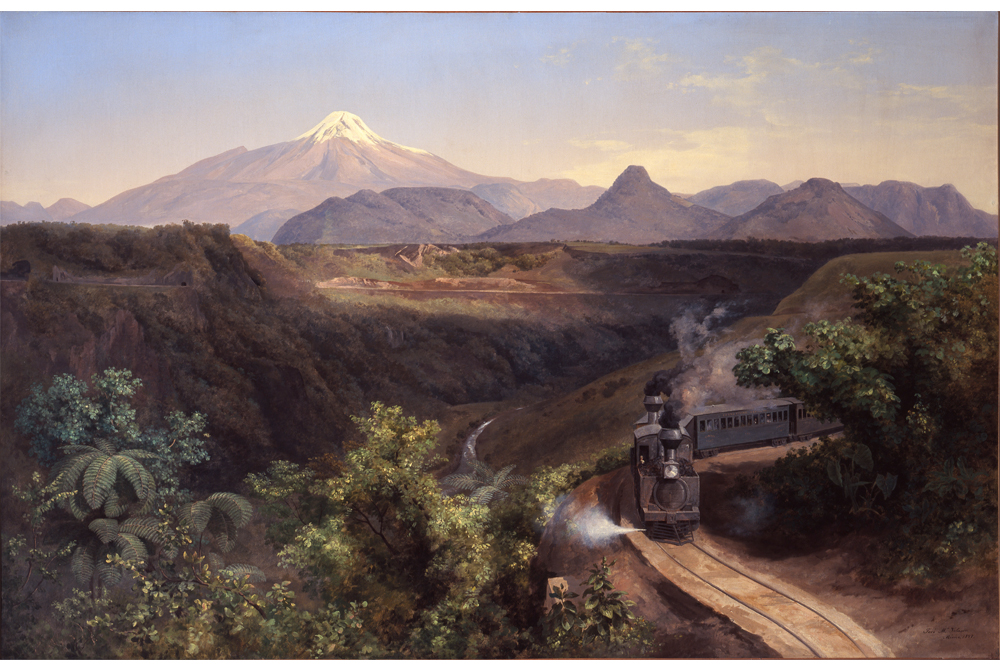“Picturing the Americas: Landscape Painting from Tierra del Fuego to the Arctic” displayed Canadian art of the past alongside 19th- and 20th-century examples from the United States, Mexico and the countries of Central and South America to identify the similarities and differences among the lands and peoples of the so-called New World. After all, these nations share a colonial past, a history of subjugating Indigenous peoples from whom ancestral lands were taken, territorial conflicts and a wealth of natural resources, and the landscape genre is well suited to illustrating the dominant ideology of Western colonizing interests and national identities.
The curators assembled a richly diverse collection of 118 landscape paintings, prints and drawings from 11 countries, dating from early 19th-century views of Mexico and Brazil by Johann Moritz Rugendas to Maria Izquierdo’s Troje of 1943. Among the precedents for bringing together the “sister nations of the Americas” were the Pan-American art exhibitions held in the US in 1901, 1925–26 and 1931, which displayed the contemporary art of each country separately. By contrast, “Picturing the Americas” effectively interspersed historical works to foster direct comparisons across national lines and under a number of broad themes related to connections between the land, people and art of the past, such as “Land, Icon, Nation,” “Field to Studio” and “Land, Encounter, Territory.”
Often, these comparisons were illuminating. Juxtaposing Cornelius Krieghoff’s Montmorency Falls (1853), Albert Bierstadt’s exaggerated view of Yosemite Valley (1868) and Félix Emile Taunay’s Guanabara Bay Seen from Snake Island, a view of Rio de Janeiro in 1828, for example, demonstrated how distinctive topographical features have taken on iconic status in their respective countries of origin. While the use of broad themes based on the land may have worked as an exhibition strategy for the 19th century, it largely falls short in the 20th. The uses to which landscape painting was put in the 20th century went largely unaddressed. Questions remain unanswered: to what extent was landscape painting still involved in the establishment of national identities in the 20th century? Did other genres supplant it? The themes, “Land Transformed” and “City as Landscape,” failed to account for key historical developments, such as the significant role of landscape painting in English Canada’s cultural decolonization after the First World War, or attempts by Latin American countries to establish a recognizably distinct form of national artistic expression around the same time.
Some juxtapositions seemed based solely on affinities of style or subject matter with no indication of their deeper significance, as in a pairing of Gabriel Fernandez Ledesma’s Industrial Landscape and Charles Sheeler’s Classic Landscape. In other instances, important connections were overlooked. Lawren Harris was deeply impressed by the work of Rockwell Kent, but their work could not be seen together in the gallery; to know the connection, one needs to read Sara Angel’s enlightening essay in the accompanying catalogue.
In order to restore the voices of Indigenous peoples, video recordings were positioned at the beginning and end of the exhibition, offering the perspectives of First Nations representatives (Hayden King, Shelley Niro and Richard Hill) on the exhibition, their relationship to place and the impact of treaties. The inclusion of archival material related to the Toronto Purchase in 1787 anchored the issue of Indigenous land rights in the here and now. However, no interpretive strategy was put in place to examine other issues that arise in a show of this nature, such as the influence of the United States on the culture, politics and economies of its neighbours to the north and south. The lone dissenting voice appeared in the form of a brief excerpt from Uruguayan writer Eduardo Galeano’s book Open Veins of Latin America: Five Centuries of the Pillage of a Continent (1971) which, inscribed on a wall in the “Land as Resource” section, criticizes European and US imperialist interests in Latin America.
Ivo Mesquita, former artistic director of the Pinacoteca do Estado de São Paulo, who conceived the show, acknowledges that many different “stories” are possible through this cross-cultural approach, of which “Picturing the Americas” was but one. The comparative approach encouraged questions about how each country fits into the broader hemispheric context, when and how countries defined their national identities through the visual arts, their relationships to the various forms of Modernism and various cross-cultural influences. The exhibition answered some of these questions, but the landscape theme proved limiting. “Picturing the Americas” may mark a step towards writing an art history of the Americas, but it is only one chapter in a much more complex story.









